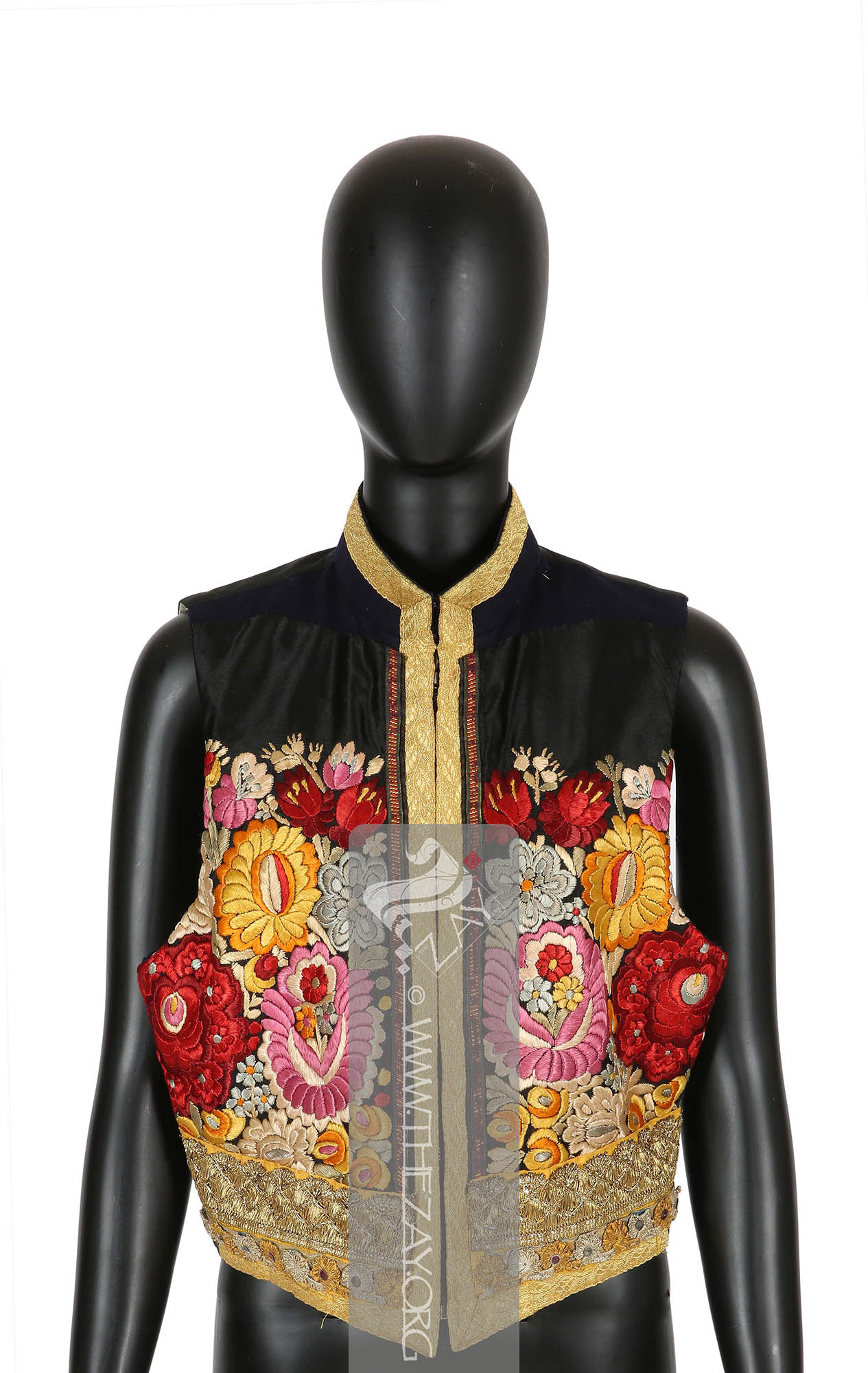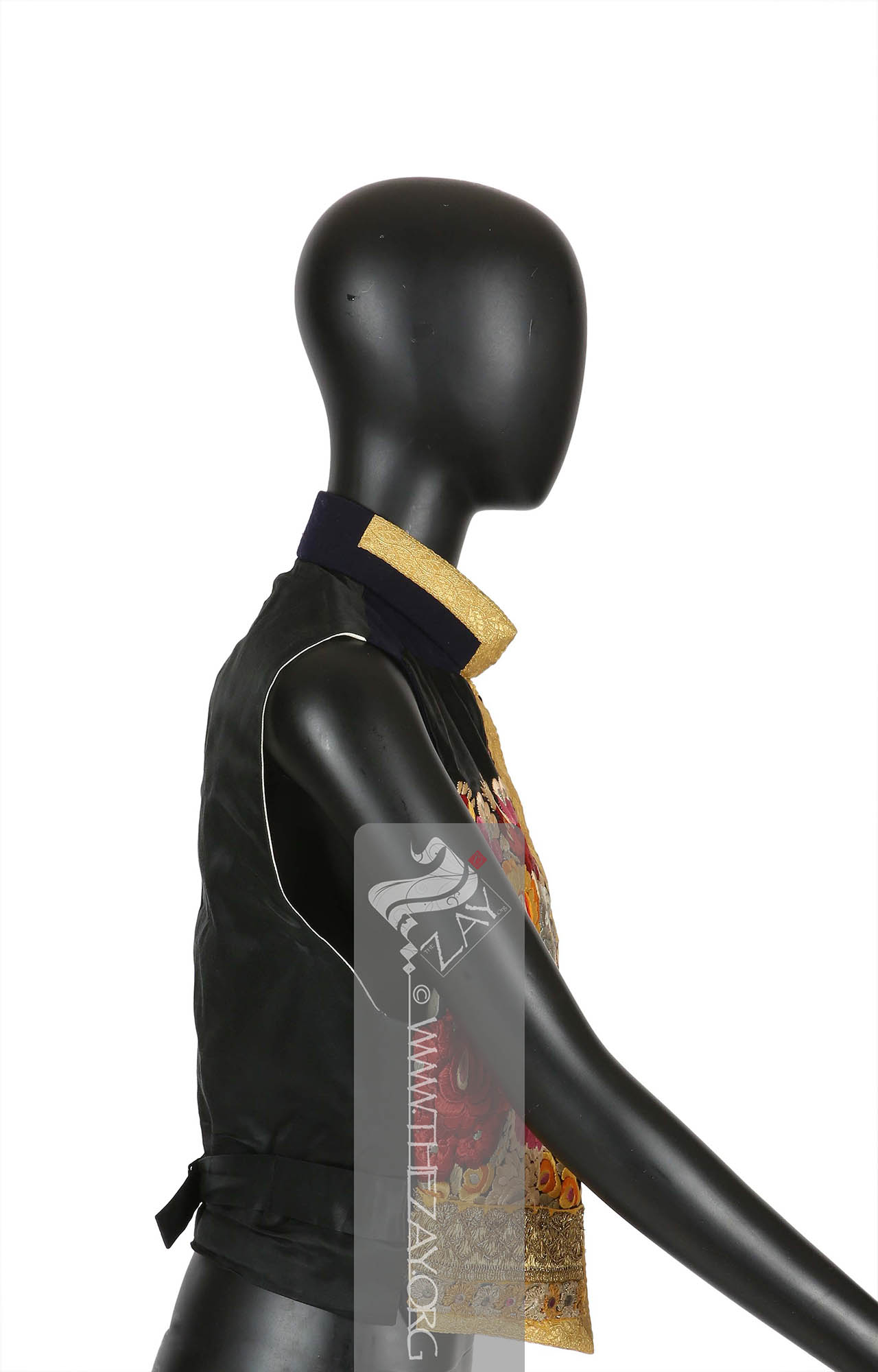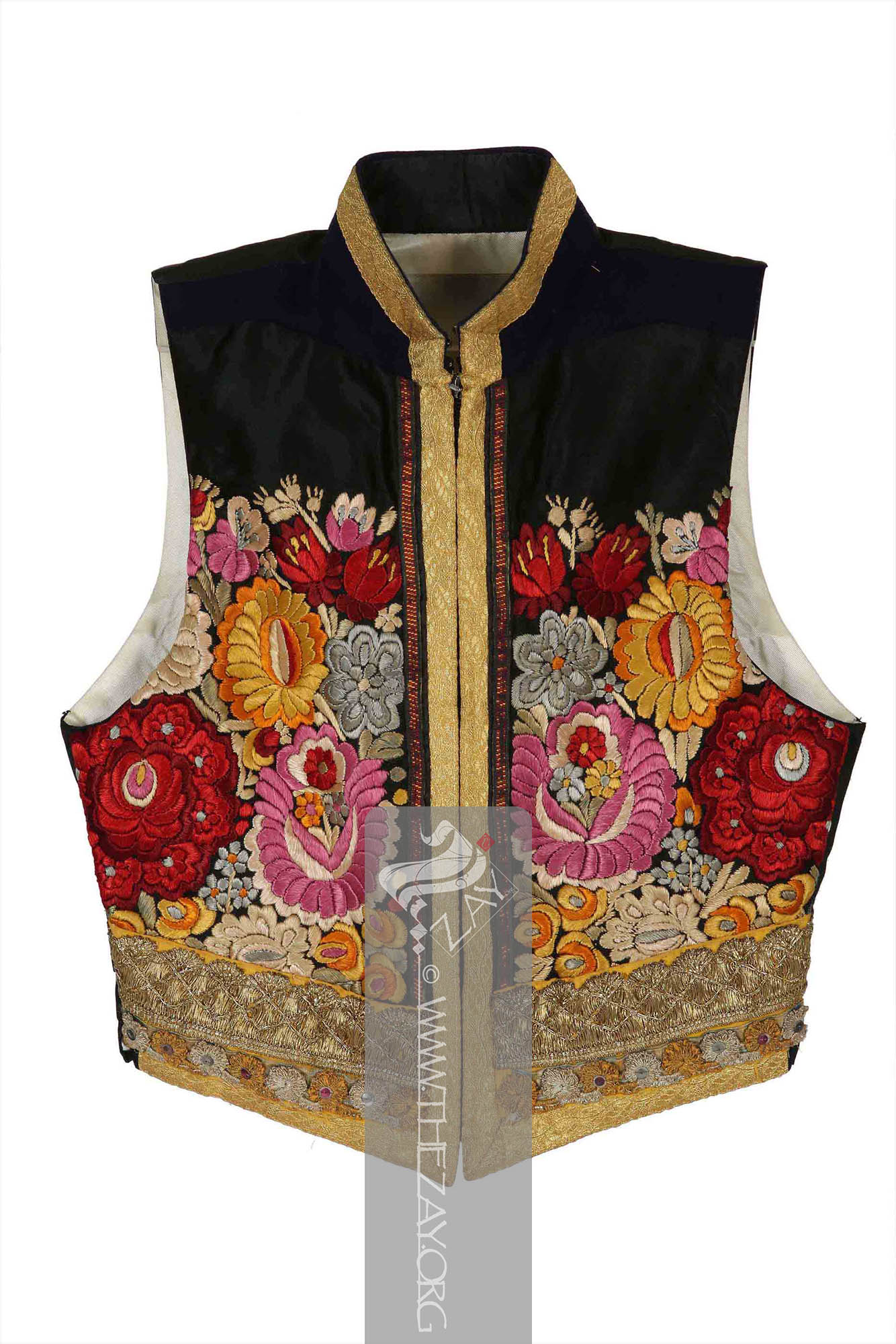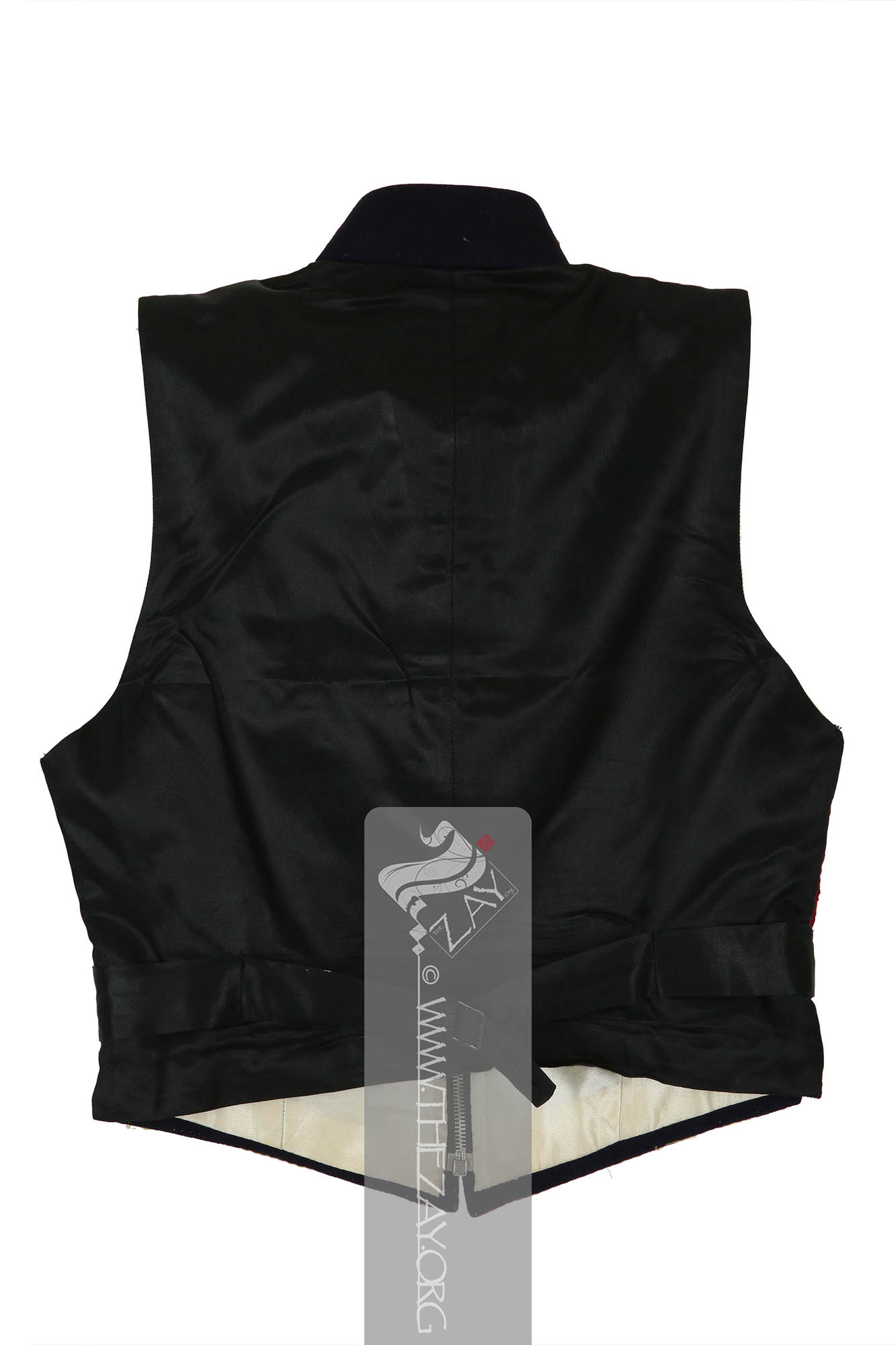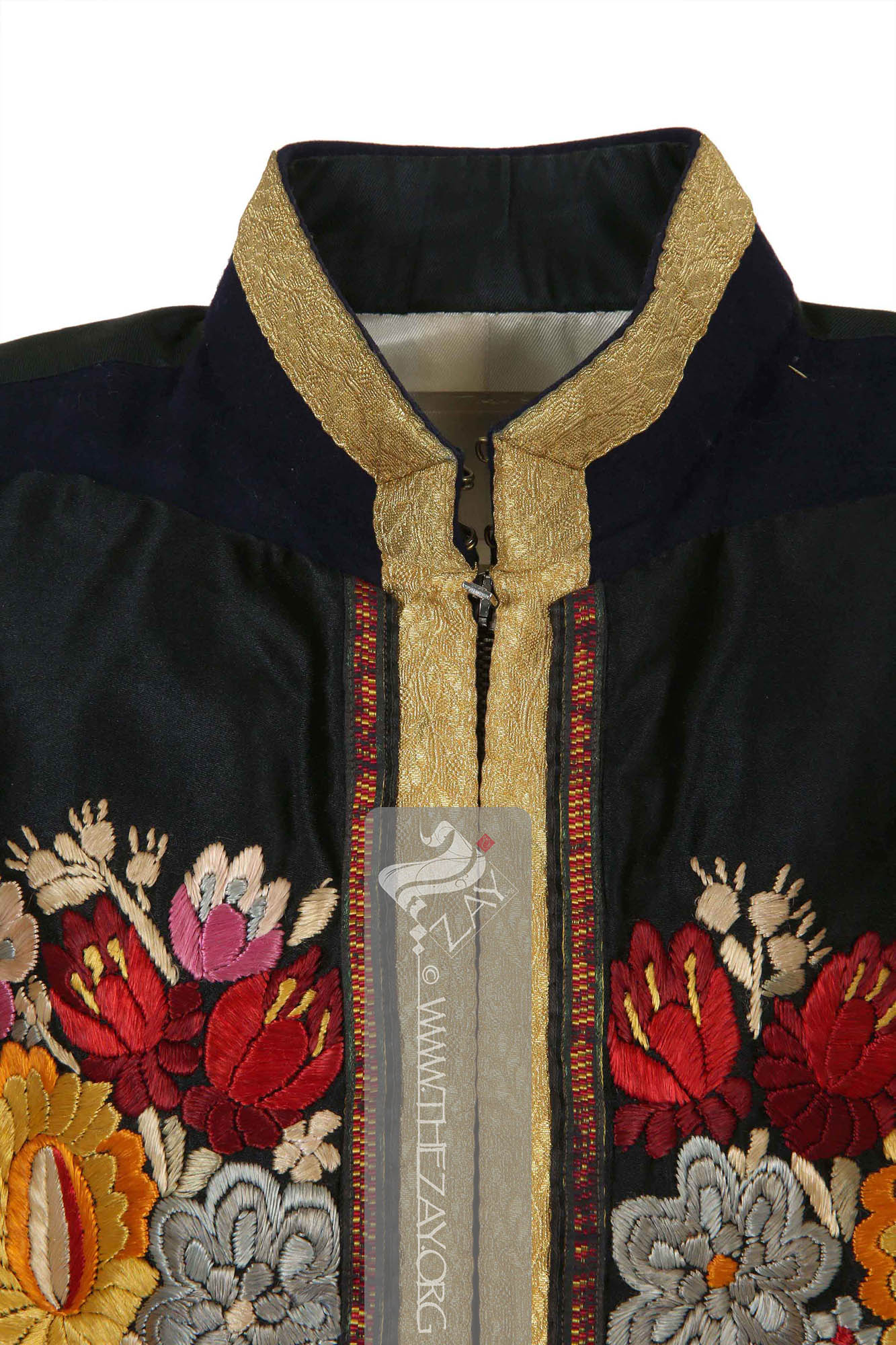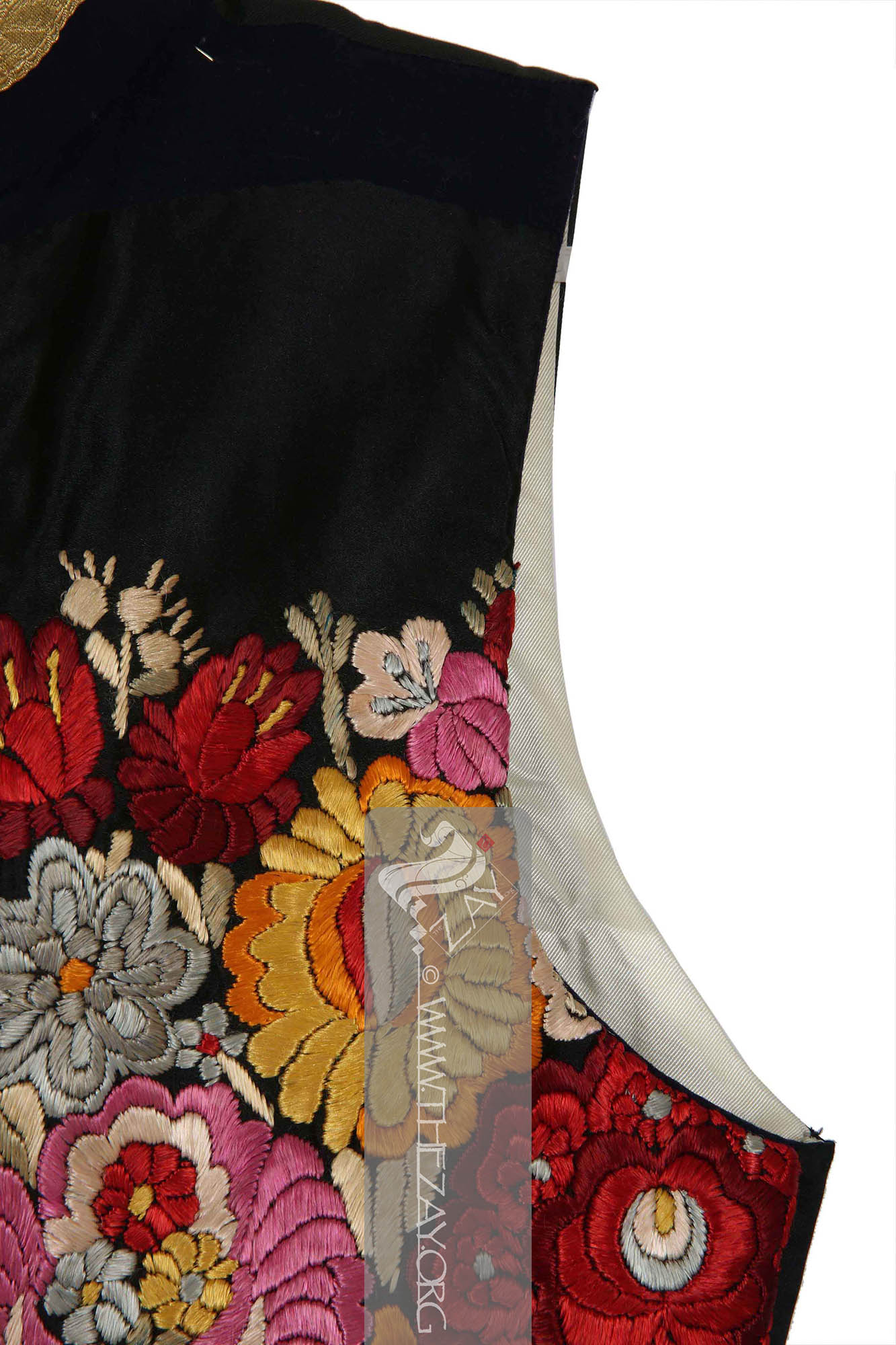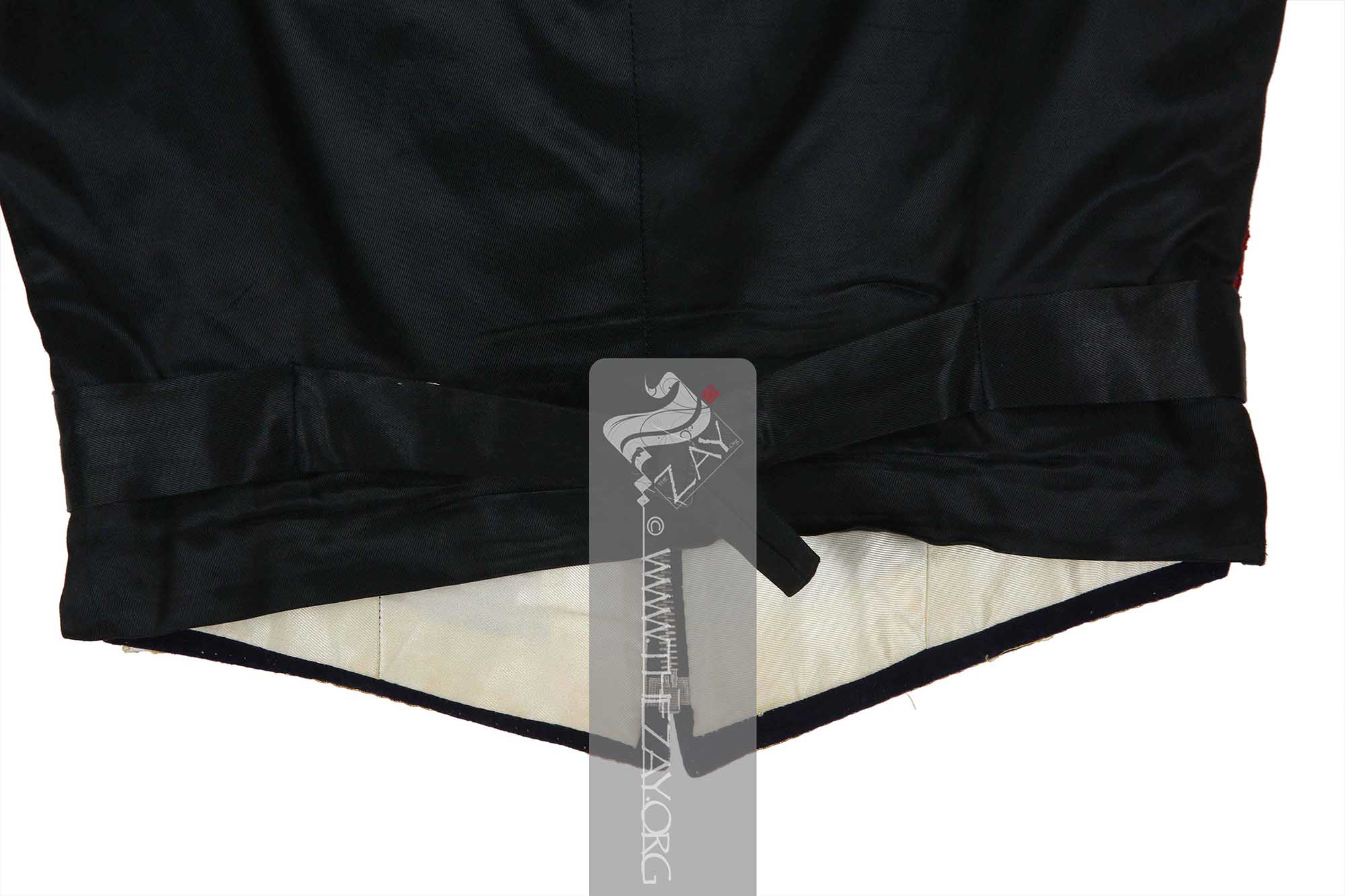Object HistoryThis Hungarian heavily embellished waistcoat dating back to c. the 1920s with heavy embroidered and gold trimmed embellishment was purchased from an independent dealer in London by
Dr. Reem Tariq
Ṭariq: (Arabic; Synonym: tulle_bi_talli
Tūlle_bi_tallī: (French: Tulle – a city in France where fine material for veil was first made; Turkish: tel – wire; Synonym: tariq; talli; badla; khus_dozi ), series of small metal knots made on a woven net ground as embellishment. The term is commonly used in the North African Arab region specifically in Egypt.
; talli; badla; khus_dozi ), series of small metal knots made on a woven net ground as embellishment. The term is commonly used in the Levant Arab region specifically in Lebanon.
El Mutwalli
Dr. Reem Tariq
Ṭariq: (Arabic; Synonym: tulle_bi_talli
Tūlle_bi_tallī: (French: Tulle – a city in France where fine material for veil was first made; Turkish: tel – wire; Synonym: tariq; talli; badla; khus_dozi ), series of small metal knots made on a woven net ground as embellishment. The term is commonly used in the North African Arab region specifically in Egypt.
; talli; badla; khus_dozi ), series of small metal knots made on a woven net ground as embellishment. The term is commonly used in the Levant Arab region specifically in Lebanon.
el Mutwallī: Founder (CEO) of the Zay
Zay: (Arabic: costume, Pl. azyaā’), a set of clothes in a style typical of a particular country or historical period. Initiative, a public figure, speaker and author. An expert curator and consultant in Islamic art and architecture, interior design, historic costume, and UAE heritage. 2017. It was added to The
Zay
Zay: (Arabic: costume, Pl. azyaā’), a set of clothes in a style typical of a particular country or historical period. Initiative to enhance its collection.
Object Features This is a man’s waistcoat in black silk in (
satin
Sātin: (Arabic: Zaytuni: from Chinese port of Zayton in Quanzhou province where it was exported from and acquired by Arab merchants), one of the three basic types of woven fabric with a glossy top surface and a dull back. Originated in China and was fundamentally woven in silk.) weave heavily embroidered in (
satin_stitch
Satin_stitch: (Synonym: Damask Stitch), is a type of flat embroidery stitch that creates a satin like smooth and shiny surface by closely spaced stitches, covering an entire area or shape.) embroidery with silk
floss
Floss: (Old French: flosche – nap of velvet), is a type of silk fibre obtained from the cocoons of wild silkworms. It is characterized by its long, fluffy fibers that are not tightly woven, making it ideal for use in various textile applications such as embroidery, lace-making, and sewing. threads in shades of red, yellow, pink, ivory and grey and two panels of (
couching
Couching: (Latin: collocare – Place together), in needlework and embroidery couching is a technique in which yarn or other materials are laid across the surface of the ground fabric and fastened in place with small stitches of the same or a different yarn
) embroidery in metal threads possibly gold and silver.
The front of the waistcoat is heavily embroidered in large floral motifs mostly peonies. The bottom of the embroidered section is edged with two tiers of metal trimmings. The first tier forms a trellis pattern with scalloped edges done in
couching
Couching: (Latin: collocare – Place together), in needlework and embroidery couching is a technique in which yarn or other materials are laid across the surface of the ground fabric and fastened in place with small stitches of the same or a different yarn
embroidery with metal threads. The next tier is embellished with a series of flowers in silver and gold metal threads with a sequin in the middle of each flower.
This is edged with a woven ribbon in gold
brocade
Brocade: (Italian: brocco – twisted thread), is a richly decorative fabric woven with an intricate raised pattern. Its origins can be traced back to ancient China, where it was made for the imperial court. It later spread to Europe during the Renaissance and became popular in couture and decorative arts. depicting a central wavy vine flanked with foliage. This gold ribbon runs along the middle parting on both sides of the zip closure and around the collar. The collar is stiff possibly lined with whale bone and is made of dark blue felt that runs along the shoulders in sharp and smart thin panels.
The back of the waistcoat is plain black
satin
Sātin: (Arabic: Zaytuni: from Chinese port of Zayton in Quanzhou province where it was exported from and acquired by Arab merchants), one of the three basic types of woven fabric with a glossy top surface and a dull back. Originated in China and was fundamentally woven in silk.. It is lined with a plain ivory
satin
Sātin: (Arabic: Zaytuni: from Chinese port of Zayton in Quanzhou province where it was exported from and acquired by Arab merchants), one of the three basic types of woven fabric with a glossy top surface and a dull back. Originated in China and was fundamentally woven in silk. fabric. Although it is not padded or quilted, it has a thick front possibly because it has a felt lining between the ivory
satin
Sātin: (Arabic: Zaytuni: from Chinese port of Zayton in Quanzhou province where it was exported from and acquired by Arab merchants), one of the three basic types of woven fabric with a glossy top surface and a dull back. Originated in China and was fundamentally woven in silk. lining and the black
satin
Sātin: (Arabic: Zaytuni: from Chinese port of Zayton in Quanzhou province where it was exported from and acquired by Arab merchants), one of the three basic types of woven fabric with a glossy top surface and a dull back. Originated in China and was fundamentally woven in silk. front. Like any other waistcoat, it has an adjustable belt at the back in black
satin
Sātin: (Arabic: Zaytuni: from Chinese port of Zayton in Quanzhou province where it was exported from and acquired by Arab merchants), one of the three basic types of woven fabric with a glossy top surface and a dull back. Originated in China and was fundamentally woven in silk..
It is important to note how the
satin_stitch
Satin_stitch: (Synonym: Damask Stitch), is a type of flat embroidery stitch that creates a satin like smooth and shiny surface by closely spaced stitches, covering an entire area or shape. embroidery and the gold metal thread work or
couching
Couching: (Latin: collocare – Place together), in needlework and embroidery couching is a technique in which yarn or other materials are laid across the surface of the ground fabric and fastened in place with small stitches of the same or a different yarn
shares such close similarities to costumes from the Middle and the Far East.
Although it had been suggested by the previous owner that it was a Hungarian military waistcoat, there are no evidence to support such a claim. However, heavy
satin_stitch
Satin_stitch: (Synonym: Damask Stitch), is a type of flat embroidery stitch that creates a satin like smooth and shiny surface by closely spaced stitches, covering an entire area or shape. embroidered embellishment such as this was quite prevalent on Hungarian vests and waistcoats of the 18th and 19th centuries, which were inspired by the Hussar regiment uniforms.
The Hussars were originally formed by bands of Serbian warriors in retaliation for the Ottoman conquest of Serbia. As a military regiment their strength and tactic were inspired by the Ottoman cavalry and possibly so were the embellishment on their uniforms.
Another possible theory is that it was possibly a (
Manila_shawl
Manila_shawl: (Manila: city in Philippines, synonyms: manton_de_seda
Manton_de_seda: (Spanish, mantón: shawl
Shawl: (Persian: shāl from Hindi: duśālā – Shoulder Mantle), a shawl is a South Asian version of a scarf worn or wrapped loosely over the shoulders and is usually made of wool. , de seda – of silk, synonyms: Canton_shawl, manila_shawl, Piano_shawl
Piano_shawl: (synonyms: manton_de_seda, Manila_shawl, Canton_shawl, manton_de_Manila) A silk embroidered shawl
Shawl: (Persian: shāl from Hindi: duśālā – Shoulder Mantle), a shawl is a South Asian version of a scarf worn or wrapped loosely over the shoulders and is usually made of wool. from Canton, China –Canton_shawl – introduced to the Manila, Philippines – a Spanish colony – through Spanish trade as it passed through its port. It became synonymous to flamenco costumes and Spanish identity and were also often draped over pianos thus Piano_Shawls., manton_de_Manila), a silk embroidered shawl
Shawl: (Persian: shāl from Hindi: duśālā – Shoulder Mantle), a shawl is a South Asian version of a scarf worn or wrapped loosely over the shoulders and is usually made of wool. from Canton, China introduced to the Manila, Philippines – a Spanish colony – through Spanish trade as it passed through its port. It became synonymous to flamenco costumes and Spanish identity and were also often draped over pianos thus Piano_Shawls., manton_de_Manila
Manton_de_Manila: (Spanish, mantón: shawl
Shawl: (Persian: shāl from Hindi: duśālā – Shoulder Mantle), a shawl is a South Asian version of a scarf worn or wrapped loosely over the shoulders and is usually made of wool. , synonyms: manton_de_seda
Manton_de_seda: (Spanish, mantón: shawl
Shawl: (Persian: shāl from Hindi: duśālā – Shoulder Mantle), a shawl is a South Asian version of a scarf worn or wrapped loosely over the shoulders and is usually made of wool. , de seda – of silk, synonyms: Canton_shawl, manila_shawl, Piano_shawl
Piano_shawl: (synonyms: manton_de_seda, Manila_shawl, Canton_shawl, manton_de_Manila) A silk embroidered shawl
Shawl: (Persian: shāl from Hindi: duśālā – Shoulder Mantle), a shawl is a South Asian version of a scarf worn or wrapped loosely over the shoulders and is usually made of wool. from Canton, China –Canton_shawl – introduced to the Manila, Philippines – a Spanish colony – through Spanish trade as it passed through its port. It became synonymous to flamenco costumes and Spanish identity and were also often draped over pianos thus Piano_Shawls., manton_de_Manila), a silk embroidered shawl
Shawl: (Persian: shāl from Hindi: duśālā – Shoulder Mantle), a shawl is a South Asian version of a scarf worn or wrapped loosely over the shoulders and is usually made of wool. from Canton, China introduced to the Manila, Philippines – a Spanish colony – through Spanish trade as it passed through its port. It became synonymous to flamenco costumes and Spanish identity and were also often draped over pianos thus Piano_Shawls., Piano_shawl
Piano_shawl: (synonyms: manton_de_seda, Manila_shawl, Canton_shawl, manton_de_Manila) A silk embroidered shawl
Shawl: (Persian: shāl from Hindi: duśālā – Shoulder Mantle), a shawl is a South Asian version of a scarf worn or wrapped loosely over the shoulders and is usually made of wool. from Canton, China –Canton_shawl – introduced to the Manila, Philippines – a Spanish colony – through Spanish trade as it passed through its port. It became synonymous to flamenco costumes and Spanish identity and were also often draped over pianos thus Piano_Shawls., manila_shawl, Canton_shawl), a silk embroidered shawl
Shawl: (Persian: shāl from Hindi: duśālā – Shoulder Mantle), a shawl is a South Asian version of a scarf worn or wrapped loosely over the shoulders and is usually made of wool. from Canton, China introduced to the Manila, Philippines – a Spanish colony – through Spanish trade as it passed through its port. It became synonymous to flamenco costumes and Spanish identity and were also often draped over pianos thus Piano_Shawls., Canton_shawl, Piano_shawl
Piano_shawl: (synonyms: manton_de_seda, Manila_shawl, Canton_shawl, manton_de_Manila) A silk embroidered shawl
Shawl: (Persian: shāl from Hindi: duśālā – Shoulder Mantle), a shawl is a South Asian version of a scarf worn or wrapped loosely over the shoulders and is usually made of wool. from Canton, China –Canton_shawl – introduced to the Manila, Philippines – a Spanish colony – through Spanish trade as it passed through its port. It became synonymous to flamenco costumes and Spanish identity and were also often draped over pianos thus Piano_Shawls.) A silk embroidered shawl
Shawl: (Persian: shāl from Hindi: duśālā – Shoulder Mantle), a shawl is a South Asian version of a scarf worn or wrapped loosely over the shoulders and is usually made of wool. from Canton, China –Canton_shawl – introduced to the Manila, Philippines – a Spanish colony – through Spanish trade as it passed through its port. It became synonymous to flamenco costumes and Spanish identity and were also often draped over pianos thus Piano_Shawls.) that had been repurposed as a waistcoat. Either way, this waistcoat is a perfect example of a homogenous cultural dissemination all the way from the Far East through the Middle and Near East to Europe.
Links 



